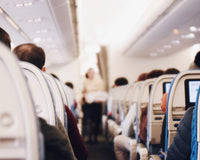For the past few months, an unexpected phenomenon has been drawing travelers’ attention: airfare to the United States has reached historically low prices. Paris–New York for under €350, Paris–Los Angeles for €180 one-way… prices once reserved for flash sales or special promotions, now available with ease.
This dramatic drop in fares brings as much excitement as it does questions. Is now the right time to plan a trip across the Atlantic? What’s behind this sudden price plunge? Beneath the surface of this bargain lie economic, tourism, and political dynamics that deserve a closer look.
Let’s break down a trend that might reshape the map of transatlantic travel.
Bargain airfare: an opportunity not to miss
In 2025, flight prices to the U.S. have hit levels not seen in years. For French travelers, it’s a golden opportunity: prices have dropped dramatically, making it easier than ever to plan a budget-friendly trip across the Atlantic.
Whether you're dreaming of New York's skyscrapers or Los Angeles' beaches, airfare is no longer a barrier.

Historic low fares on transatlantic routes
While round trips to the U.S. often exceeded €600, one-way tickets are now available at unbeatable prices. A Paris–Los Angeles flight is offered around €180 with French Bee, nearly half the usual cost.
The same goes for New York, with one-way fares around €300 or less, depending on the season and airline. This nearly 50% drop represents a major break from the inflationary trend that’s dominated air travel in recent years.
The perfect time for american travel dreams
For travelers with limited budgets or those still undecided, these falling prices are a real game changer. The U.S. has rarely been so financially accessible.
While prices remain volatile, experts agree that May and June 2025 are ideal for booking, just before the summer rush. With some flexibility, significant savings can be made—without compromising on your dream destination.
Why are US flights so cheap in 2025?
The stunning drop in fares isn’t just a marketing stunt—it reflects major shifts in tourism demand, economic balance, and airline strategies in a complex international context.

Tourism demand in sharp decline
A key factor is the decline in international tourism to the U.S. Since Donald Trump’s return to the presidency, the country's image has cooled among many French travelers.
In March 2025, travel intentions to the U.S. fell by 25% year-over-year, according to consulting firm Protourisme. Tour operators confirm this with a 30% drop in bookings. Political factors, combined with the lingering effects of the health crisis, have shifted many tourists’ priorities.
Fewer business trips, more empty seats
The drop in business travel is another major factor. Remote work is here to stay in many industries, reducing the need for international travel.
As a result, airlines are facing lower occupancy, especially in business class, which is typically highly profitable. To make up for lost revenue, they’ve adopted more aggressive pricing strategies, particularly in economy class—a policy that clearly benefits leisure travelers.
Cheap flights... but at what cost?
Flying to the U.S. on the cheap may seem like a golden opportunity, but these low prices come with trade-offs. From comfort to temporary pricing, and the financial health of airlines, travelers should be informed before booking.
Possible drop in quality with low-cost airlines
These enticing fares often come with compromises in comfort and service. Airlines like French Bee offer ultra-low fares, but they often mean:
- paid meals
- no checked luggage included
- limited seat selection
- longer layovers
For families or travelers sensitive to comfort, these details can quickly raise the final cost.
Short-lived deals
Another warning: these ultra-low fares are unlikely to last. They reflect a temporary context—weakened demand, less tourism, and fewer business trips—and could rise quickly if the market picks up. Travel professionals are even forecasting a last-minute rebound by summer 2025.
In short, timing is key, as prices may surge again once demand recovers.
Financial pressure on airlines
Such aggressive pricing raises questions about the sustainability of the airline industry.
Flying at a loss, even temporarily, is not viable long-term. If airlines can’t balance their books, it could lead to:
- reduced flight frequencies
- canceled routes
- even bankruptcies in extreme cases
This would ultimately impact travelers by limiting future options.
Cheaper flights, but expensive stays
Finally, while airfare is more accessible, the overall cost of a U.S. trip remains high.
In cities like New York and Los Angeles, inflation continues to drive up prices for accommodation, dining, and activities. The money saved on the flight may be quickly offset by on-site expenses.
Key takeaways from the price drop
The sharp fall in airfare to the U.S. in 2025 is clearly a rare chance for travelers. With one-way transatlantic flights under €200, it’s suddenly possible to realize a travel dream that once seemed unaffordable. This trend is driven by:
- a drop in tourism demand
- fewer business trips
- airlines eager to fill their planes at any cost
But behind these tempting deals lie important realities: reduced services, unstable prices, and costly stays. Weighing the pros and cons is essential before booking.
In short, these low fares are a great opportunity—if you travel smart, stay flexible, and consider the full cost of your trip. For those dreaming of America, now may be the time—while the window remains open.












